
|
|
December 17-24, 2004
We (Still) Love L.A.: Mount Wilson (part one)
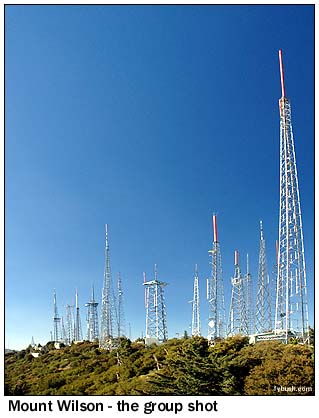 It's
Tower Site
Calendar 2005 season right now here at fybush.com, which
gives us a chance not only to showcase the images featured in
next year's calendar - but also to do some Very Special Tower
Sites of the Week that relate to next year's calendar images...and
just maybe, a preview of Tower Site Calendar 2006.
It's
Tower Site
Calendar 2005 season right now here at fybush.com, which
gives us a chance not only to showcase the images featured in
next year's calendar - but also to do some Very Special Tower
Sites of the Week that relate to next year's calendar images...and
just maybe, a preview of Tower Site Calendar 2006.
For the last few years, the calendar has featured at least one image each year from one of our favorite markets, Los Angeles. The nation's number-two market (or if you count by revenue, as many LA radio folks do, the number-one market) has a little of everything - nifty directional arrays, huge I-A clear channel AM signals, antique "hammock" AM longwires (KYPA 1230, "Miss November" in the 2005 calendar), and one of the most impressive mountaintop TV/FM sites to be found anywhere.
That would, of course, be the legendary Mount Wilson, nearly a mile above sea level (5715 feet at the Mount Wilson Observatory, to be exact), yet within sight (on a clear day) of the entire Los Angeles basin and the Pacific Ocean beyond. That's something like 10 million people within the line of sight of this mountaintop, which means it was no surprise that it's the site of choice for nearly all the FM and TV stations that serve this magnificent market.
There are, in reality, five groups of towers that make up this site, each one distinctly visible (and all but one readily accessible by road) as you make the long drive up from the valley below. (It's only a few miles as the crow flies from the summit of Mount Wilson to Pasadena, directly below, but the twisty drive up the Angeles Crest Highway and Red Box Road takes the better part of an hour from La Canada-Flintridge, where the highway begins.)
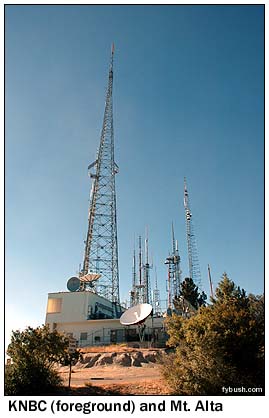 The
"group shot" shown here takes in the two most prominent
clusters of towers. On the left is the area known as "Mount
Alta," the absolute peak of the mountain and the first spot
to be developed for broadcast use. Beyond it, to the east about
half a mile away, is the 1000-foot guyed tower of KCBS-TV, the
only one of its kind on the mountain (we'll come back to that
site in part two, next week.) The wide candelabra tower in the
center and the towers to the right of it are all part of the
"Fox compound." Out of frame to the left - down a ravine
and up another hill to the south - is Mount Harvard, the most
recently developed site in the area. And a small cluster of towers
- which we'll also see in a bit - sits between Alta and the CBS
compound. (We'll get there - and to Mount Harvard - next week
as well.)
The
"group shot" shown here takes in the two most prominent
clusters of towers. On the left is the area known as "Mount
Alta," the absolute peak of the mountain and the first spot
to be developed for broadcast use. Beyond it, to the east about
half a mile away, is the 1000-foot guyed tower of KCBS-TV, the
only one of its kind on the mountain (we'll come back to that
site in part two, next week.) The wide candelabra tower in the
center and the towers to the right of it are all part of the
"Fox compound." Out of frame to the left - down a ravine
and up another hill to the south - is Mount Harvard, the most
recently developed site in the area. And a small cluster of towers
- which we'll also see in a bit - sits between Alta and the CBS
compound. (We'll get there - and to Mount Harvard - next week
as well.)
Mount Alta
We'll start our visit with Mount Alta, the most accessible and most impressive cluster of towers on the mountain. KTLA (Channel 5), the television pioneer of the west, blazed the trail here, transmitting experimentally from the Paramount lot on Melrose Avenue as early as the late thirties and operating commercially from Mount Wilson beginning in 1947. Within just a few years, KTLA was joined here by KNBH (Channel 4, now KNBC), KECA-TV (Channel 7, now KABC-TV) and KFI-TV (Channel 9, later KHJ-TV and now KCAL-TV).
A bit of history before we begin exploring: Like its "W" counterpart in the east, New Hampshire's Mount Washington, Mount Wilson had a long history as a resort destination before becoming a broadcast site. Unlike Mount Washington, Wilson was also one of the nation's premiere sites for astronomy, and even with all the light pollution from the basin below, the Mount Wilson Observatory remains an active scientific facility. (Among its highlights is the 100-inch reflecting telescope that was for some years the nation's largest.)
Former KFI/KOST chief engineer Marvin Collins, who was my tour guide on the crisp October afternoon I recently spent at Mount Wilson, has chronicled the mountain's pre-broadcast history far better than I ever could, and you can read his history here.
 But
you're not here for the toll road or the early auto races or
the Center for High Angular Resolution Astronomy (as cool as
that is, and you can see pictures on Marvin's pages) - you're
here for the towers, and Mount Wilson has them. So let's drive
up Red Box Road, past the CBS gate and the handful of towers
just past that site, until we reach the west side of Mount Alta.
That's where the road turns into a one-way loop that encircles
Mount Alta, heading down below the summit and past the back of
the old Pacific Bell/AT&T microwave buildings (seen in the
photo at right, taken as dusk descended on the mountain) before
coming around to the parking lot at the east end of Alta where
that KNBC photo (above) was taken. Here, you can turn left into
the heart of the Mount Alta farm, passing the front of the KNBC
building, the little KOST transmitter building next door, and
arriving in front of the KTLA building. Yeah, it's nondescript
- presumably there are microwave dishes back there behind that
plastic sheeting - but so much history has happened here. (Just
one example: KTLA's brilliant chief engineer, the legendary Klaus
Landsberg, coordinated a live broadcast of the nuclear
testing in the Nevada desert, building a three-hop microwave
network that stretched from the middle of the desert to Mount
Wilson...in 1952!)
But
you're not here for the toll road or the early auto races or
the Center for High Angular Resolution Astronomy (as cool as
that is, and you can see pictures on Marvin's pages) - you're
here for the towers, and Mount Wilson has them. So let's drive
up Red Box Road, past the CBS gate and the handful of towers
just past that site, until we reach the west side of Mount Alta.
That's where the road turns into a one-way loop that encircles
Mount Alta, heading down below the summit and past the back of
the old Pacific Bell/AT&T microwave buildings (seen in the
photo at right, taken as dusk descended on the mountain) before
coming around to the parking lot at the east end of Alta where
that KNBC photo (above) was taken. Here, you can turn left into
the heart of the Mount Alta farm, passing the front of the KNBC
building, the little KOST transmitter building next door, and
arriving in front of the KTLA building. Yeah, it's nondescript
- presumably there are microwave dishes back there behind that
plastic sheeting - but so much history has happened here. (Just
one example: KTLA's brilliant chief engineer, the legendary Klaus
Landsberg, coordinated a live broadcast of the nuclear
testing in the Nevada desert, building a three-hop microwave
network that stretched from the middle of the desert to Mount
Wilson...in 1952!)
If we were to continue down "Video Road" at this point, we'd pass the U.S. Post Office (yes, there's a fully functional post office up here), the "John Poole Building" (named for another L.A. broadcast pioneer, who put KBIG-FM 104.3 and KBIC-TV 22 on the air here when FM and UHF-TV were still thought commercially unviable), and eventually we'd end up back at the west side of the summit.
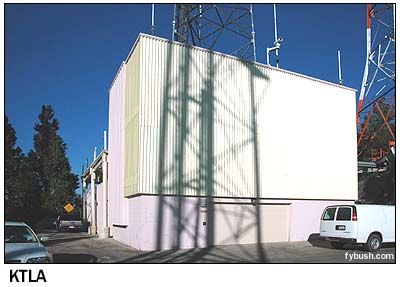 |
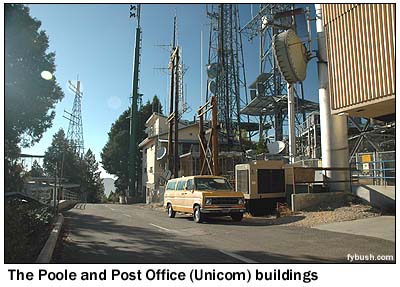 |
Instead, we turn right at KTLA, passing behind the post office building to reach a big white building that's been home to ABC's operations on the hill since the late forties. What was KECA-TV (Channel 7) in time became KABC-TV, and the former KECA-FM (95.5) became KABC-FM and then KLOS. In the late nineties, KABC-DT (Channel 53) joined the family up here as well. And thanks to KLOS chief engineer Norm Avery (like your editor, an alumnus of Boston's WBZ), we're able to get inside the gate and see what it all looks like. KLOS rocks the Southland from a pair of BE transmitters on the first floor, with KABC-DT's Thales transmitter down the hall in a former garage space. Upstairs, a classy row of "Harris blue" cabinets frames the windows into the KABC-TV transmitter room, nicely fitted out with matching Harris transmitters.
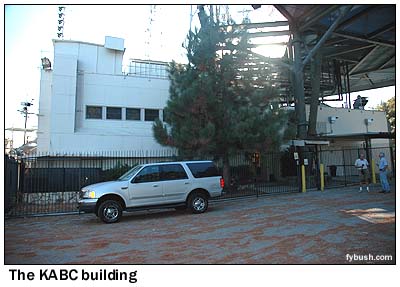 |
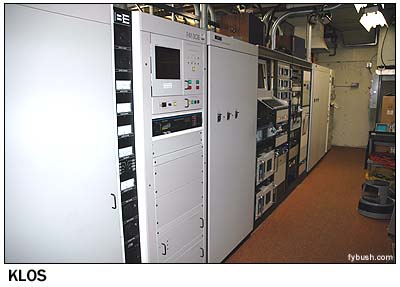 |
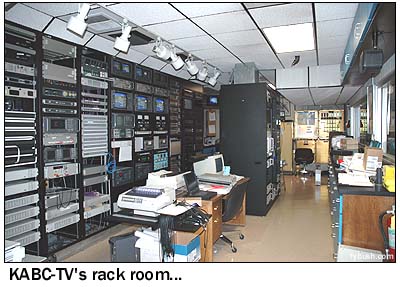 |
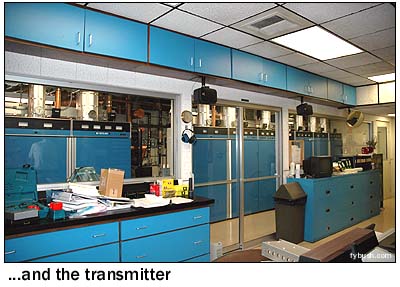 |
The KABC tower is distinctive among the array of Alta towers because it alone has a stairway wending its way to the top. (It's also distinctive for the separate antenna elements for channel 7's visual and aural signals; the KLOS bays sit just below those, with KABC-DT side-mounted at a lower level.
The road past KABC dead-ends at the gate to the easternmost of the Alta towers, the big self-supporter that belongs to KCAL-TV (Channel 9). This site was built in 1948 for Packard dealer Earle C. Anthony's KFI-TV and KFI-FM (95.5), which had the distinction of being perhaps the least successful TV stations in the market in the era. (Anthony had also owned - and given his initials to - KECA 790, which begat KECA-TV. When the FCC abolished duopolies in 1943, Anthony sold KECA to the fledgling ABC network, which explains why KECA radio and TV eventually became KABC radio and TV.) After just three years, Anthony was plagued with union problems and ready to sell out to the Don Lee company, whose KHJ radio had been a major rival to KFI/KECA, just as Lee's Cadillac dealership was a rival to Anthony's Packard operation. Lee, in turn, sold its KTSL (Channel 2) to CBS, which was dissolving its joint ownership (with the Los Angeles Times) of KTTV (Channel 11). But we're getting ahead of ourselves here; the point is that KFI-TV became KHJ-TV, and KHJ-FM (formerly K45LA, a pioneer of West Coast FM) moved up here from downtown Los Angeles, eventually becoming KRTH-FM (101.1).
(More ironies here: KHJ-TV/KRTH eventually became part of the RKO family, and were then sold off when RKO's broadcast operation was broken up in the late seventies/early eighties. KHJ-TV ended up in Disney's hands, becoming KCAL-TV, then had to be spun off again when Disney bought ABC in 1986. After a decade under Young Broadcasting ownership, KCAL-TV became part of a Viacom duopoly with KCBS-TV - and in the meantime, KRTH, which had ended up in the hands of Infinity Radio, also became a Viacom property. So KRTH, which still shares the channel 9 tower, is once again co-owned with the TV station.)
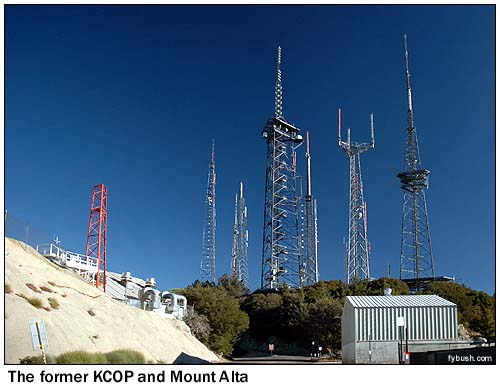 There
is much more now transmitting from Alta, using several towers
(and a few monopoles) that fill the space just south of the ABC
property and east of KCAL-TV. KMEX-TV (Channel 34) signed on
up here in the sixties as a pioneering Spanish-language station
and today, as Univision's L.A. flagship, shares a candelabra
tower with Telefutura outlet KFTR (Channel 46). John Poole's
KBIC (Channel 22) eventually became Spanish-language KWHY (Channel
22). Much, much later, these towers would also become home to
infomercial-laden KXLA (Channel 44), Azteca America's KAZA (Channel
54), and Orange County move-ups KOCE (Channel 50) and KDOC (Channel
56). And there are several FMs up in this cluster as well: KPCC
(89.3), KHHT (92.3) and KKBT (100.3) have transmitters in the
Post Office building, as does KLSX (97.1). KIIS (102.7) is up
here, too, as is pioneering KBIG (104.3). And KPWR (105.9) shares
the channel 9 tower with KRTH.
There
is much more now transmitting from Alta, using several towers
(and a few monopoles) that fill the space just south of the ABC
property and east of KCAL-TV. KMEX-TV (Channel 34) signed on
up here in the sixties as a pioneering Spanish-language station
and today, as Univision's L.A. flagship, shares a candelabra
tower with Telefutura outlet KFTR (Channel 46). John Poole's
KBIC (Channel 22) eventually became Spanish-language KWHY (Channel
22). Much, much later, these towers would also become home to
infomercial-laden KXLA (Channel 44), Azteca America's KAZA (Channel
54), and Orange County move-ups KOCE (Channel 50) and KDOC (Channel
56). And there are several FMs up in this cluster as well: KPCC
(89.3), KHHT (92.3) and KKBT (100.3) have transmitters in the
Post Office building, as does KLSX (97.1). KIIS (102.7) is up
here, too, as is pioneering KBIG (104.3). And KPWR (105.9) shares
the channel 9 tower with KRTH.
This view from the west side of Alta presents the landscape pretty clearly: at right is the KCAL-TV tower, with the Univision candelabra to its left. That's KNBC in the distance to the left of the candelabra (with several FMs on a little monopole in there as well), and the distinctive KABC tower, with its stairs up the middle and its separate visual/aural bays, at the center. Off in the distance to the left of KABC is the Fox compound, and to the left of that is KTLA.
(That's a lot of RF, especially when you consider that most of the FMs up here are grandfathered at powers far above what they'd normally be allowed at heights of around 900 meters - some 2700 feet - above average terrain. KBIG, in particular, runs 84 kW from less than 100 feet above the ground, and several of the stations here - including KBIG - have been fined by the FCC in recent months for contributing to RF levels that exceed the allowed maximum on several of the roads on Mount Alta.)
All the way at the left, we see a tower base that was the original home, in 1949, of KMTR-TV (Channel 13). Marvin Collins reports that KMTR was in such a hurry to get on the air that its transmitter went on from a tent below the tower while a building was hurriedly erected around it. KMTR eventually became KCOP-TV, one of four VHF independents in this crowded market, and a few years back it was sold to Fox to become a duopoly with KTTV - and that brings us to...
The Fox Compound
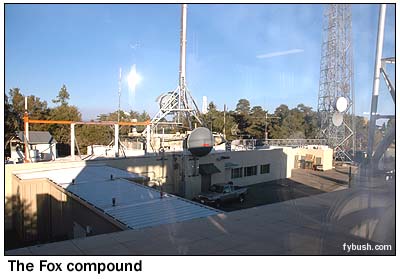 Returning
to the large parking area at the east side of Alta, we're faced
with several options. We've already explored Video Road, back
up the middle of Alta. At the south end of the parking lot, a
big gate blocks a road leads down the path of the old Mount Wilson
Toll Road to Mount Harvard. (We'll explore that next week.) At
the north end of the lot sits a pay phone, which is actually
pretty important up here, since cell phones don't work. And at
the east end is another set of gates that leads into the grounds
of the old Mount Wilson Hotel and up to the observatory. On weekends,
these gates are open (at least when there's not a severe fire
warning - much of the land up here, including the parking lot
beyond the gate, is part of the Angeles National Forest) and
the public can tour the grounds of the observatory. Or - and
you'll forgive us if we think this is even cooler - if you're
up on the mountain with Marvin, you can visit the Fox compound,
which runs along the south side of the road to the observatory.
Returning
to the large parking area at the east side of Alta, we're faced
with several options. We've already explored Video Road, back
up the middle of Alta. At the south end of the parking lot, a
big gate blocks a road leads down the path of the old Mount Wilson
Toll Road to Mount Harvard. (We'll explore that next week.) At
the north end of the lot sits a pay phone, which is actually
pretty important up here, since cell phones don't work. And at
the east end is another set of gates that leads into the grounds
of the old Mount Wilson Hotel and up to the observatory. On weekends,
these gates are open (at least when there's not a severe fire
warning - much of the land up here, including the parking lot
beyond the gate, is part of the Angeles National Forest) and
the public can tour the grounds of the observatory. Or - and
you'll forgive us if we think this is even cooler - if you're
up on the mountain with Marvin, you can visit the Fox compound,
which runs along the south side of the road to the observatory.
We alluded earlier to the CBS/Los Angeles Times partnership that put KTTV (Channel 11) on the air in 1948, using this piece of land just east of Mount Alta. The initial structure, as best I can discern, is shown at the center of this view: a building that housed transmitters and an apartment for the engineers who manned the site year-round, with a slot antenna mounted on the roof. In later years, as Metromedia bought KTTV and added KMET (94.7) to its holdings, that slot antenna would be used for the FM - and indeed, it's still a usable auxiliary for 94.7. Later, new towers for channel 11 would be built at the east and west ends of the building. And then, with the advent of digital TV and the acquisition of KCOP, Fox (which had bought KTTV as part of its group buy of Metromedia) decided it needed much more space up here, building a four-story building crowned by a fat candelabra tower, the whole thing cantilevered out over the edge of the mountain. (We're standing out on the roof of that new building to take the photo above; that's a two-story passageway connecting the new building to the old at the left of the frame.)
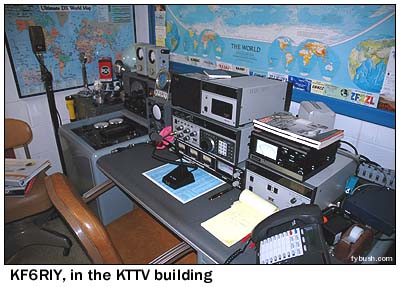 |
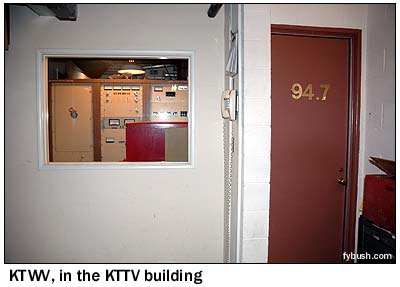 |
The older portion of the Fox building is where our tour starts, and there's still plenty to see - the apartment where the engineers still live during their weeklong shifts on the mountain, the old NEC transmitter for channel 11, a pair of more recent auxiliary transmitters for 11 (a Comark) and 13 (a Harris), and the KCOP-DT (Channel 66) Thales transmitter.
94.7 is still here, though it's been many years since it was co-owned with KTTV. It's now KTWV, the Wave, and it's owned by Infinity, with a pair of Continentals in their own little room. And right next door, another room houses KF6RIY, the beautifully-appointed (that's a DAP audio processor sitting on the middle of the desk!) ham station that belongs to KTTV engineer Jay Simmons. (When he's not doing ham radio up here, he's restoring vintage RCA TV cameras in another room. Oh, and there are longwire ham antennas strung up next to the old slot antenna up on the roof. Very neat...)
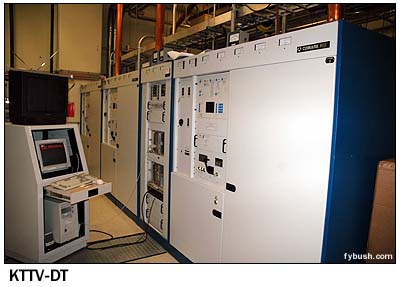 |
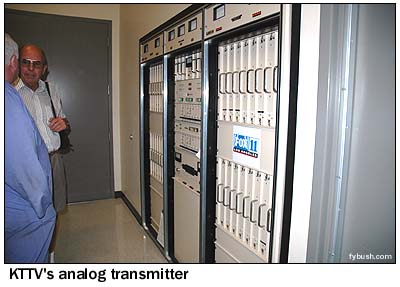 |
Passing through the corridor into the new building, we see the large room that's home to KTTV-DT (Channel 65)'s Comark; down the hall is a smaller room that houses the primary transmitters, both Comarks, for KTTV and KCOP's analog signals.
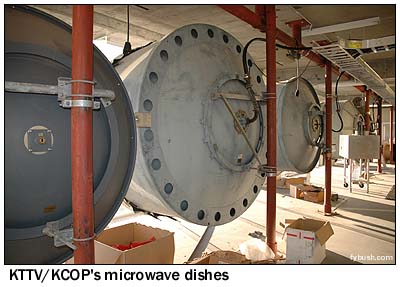 |
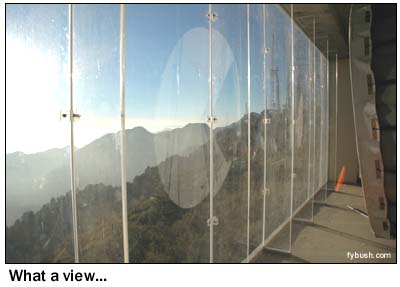 |
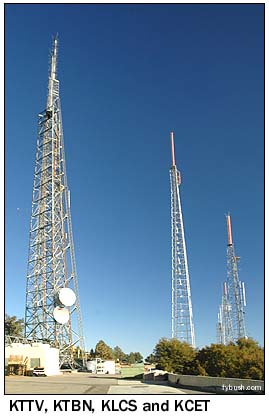 Down
one floor are the power and HVAC facilities for the new building,
and down still another flight of steps is the generator, overlooking
the cliff that slopes way, way down to the valley far below.
And up one floor from the transmitters are the microwave dishes
that link this site with the KTTV/KCOP studios in West L.A. There
is snow up here in the winter, and so the dishes sit in an enclosure
behind big plexiglass windows that offer a spectacular view of
the mountain. (Look carefully and you can see some of the Alta
towers in the right side of the window.)
Down
one floor are the power and HVAC facilities for the new building,
and down still another flight of steps is the generator, overlooking
the cliff that slopes way, way down to the valley far below.
And up one floor from the transmitters are the microwave dishes
that link this site with the KTTV/KCOP studios in West L.A. There
is snow up here in the winter, and so the dishes sit in an enclosure
behind big plexiglass windows that offer a spectacular view of
the mountain. (Look carefully and you can see some of the Alta
towers in the right side of the window.)
Walk back outside and look to the east, and there's a nice view of more of the KTTV towers (there are four on the property, and the analog signals for 11 and 13 can be switched into antennas mounted on each of them, as needed) and of three more towers that are the easternmost on Alta.
KCET (Channel 28), the premiere public TV station in Los Angeles, is on one of these towers, with the L.A. public schools' KLCS (Channel 58) next door. And TBN's KTBN (Channel 40) is here as well, as are KSCA (101.9) and Salem's KKLA (99.5).
That's a lot of FM and TV to look at - and we're still not at all finished with the majesty of Mount Wilson. Next week, we'll see what's sitting down at the end of the Mount Harvard road, we'll explore the interesting little sites west of Mount Alta - and we'll see the interesting history behind the tall tower of KCBS-TV, too.
Special thanks to Marvin Collins and to the engineering staffs of KABC/KLOS and KTTV/KCOP for making our visit so enjoyable!
 It's here - the
2005 Tower Site Calendar is now shipping! Click
here for ordering information!
It's here - the
2005 Tower Site Calendar is now shipping! Click
here for ordering information!
- Previous Site of the Week: We (Still) Love L.A.: KNX, KCBS-TV and KFWB, present and future
- Next Week: We (Still) Love L.A.: Mount Wilson, part II
- Site of the Week INDEX!
- How can you help support Site of the Week? Click here!
- Submit your suggestions for a future Site of the Week!
